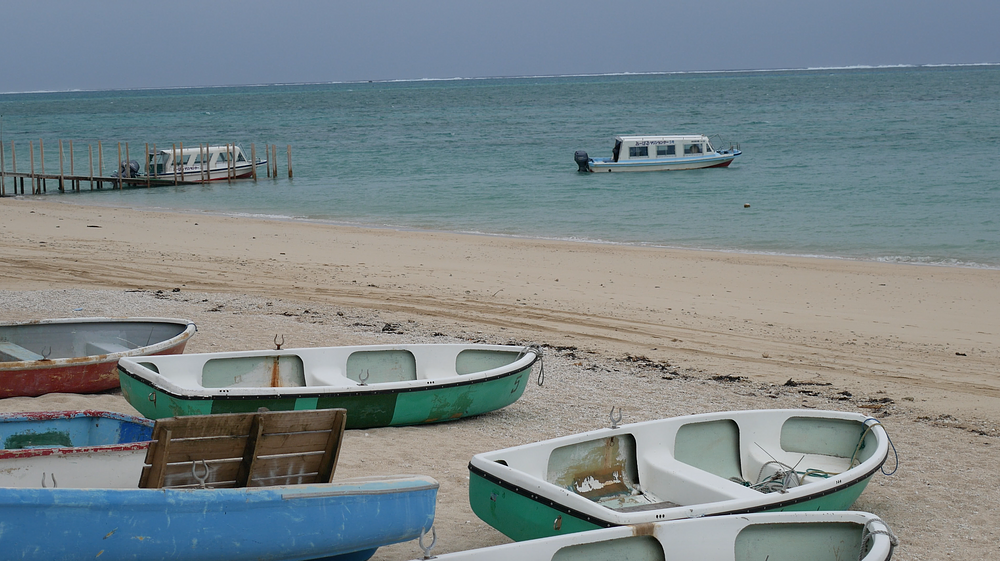About Okinawa culture
Okinawa's native religion is called Nirai Kanai, named after their Holy Land of the same name. Nirai Kanai is a place only separated by the sea, some say it is even under the sea. Funny anecdote, the "palace under the sea" that appears in many Japanese and Chinese legends (such as Urashima Tarou) is called Ryukyu and the old name for Okinawa Islands is also "Ryukyu islands", so some people think Ryukyu Palace is actually Nirai Kanai.
The Okinawa religion venerates ancestors, both family who has died and the first gods who were ancestors of us all: the father (heaven), the mother (land) and the sea, as well as many other smaller gods. Out of these, Amamikyu is the main protagonist of many myths and legends. Amamikyu created Okinawa from her home in Nirai Kanai, starting with sacred Seifa Utaki. She then landed on Kudaka Island, built two castles and, among other things, magically birthed her male counterpart who would help her populate the islands. As part of my visit, I wanted to visit the sites of these legends, namely Seifa Utaki, the island and castles.
DAY 4) NANJO: Seifa Utaki
I took a bus from Naha’s Kamiizumi Bus Terminal to Seifa-utaki, the first stop of the pilgrimage. If you’re there at opening time, when you come across the trail crossroads, head to the right first. When I was there, everyone (myself included!) took the left turn first but the main prayer sight is the other way so you may avoid the first wave of people by starting there. It was overall much smaller than expected but it was a clear day so we had clear visibility of sacred Kudaka Island from the shrine.
After Seifa Utaki I started the walk, it turned out to be around 6h altogether: up Nirai Kanai bridge (named after the sacred land, but also has a fantastic panoramic over Nanjo, the brown sugar fields and some dark patches in the sea which are seaweed plantations) and to Chinen Castle ruins (beware of habu snakes if you’re going down into the bushes). From the road under the castle I took a bus to the Hyakuna Bus Terminal (百名バスターミナル) and then stopped by some tombs and utaki along the way to the scenic Mibaru Beach. I had lunch at Yama no chaya, my favourite restaurant in Okinawa, it has an upstairs with views of the ocean, a downstairs with lots of beautiful paintings by Okinawan artists and the outside area with a couple tables in the forest.
I tried to make it to Tamagusuku castle ruins but unfortunately got a bit lost and I was tired of walking, so I just took the bus to Yonabaru, where I’d be sleeping for the next couple nights, instead of having to go all the way back to Naha. I guess this day doesn't sound the most interesting since it's just walking around, but knowing the stories behind all these places makes it much more worthwhile!
DAY 5) NANJO: Kudaka Island
I bought some lunch at a convenience store in Yonabaru and then caught an early bus to the Azama Sun-sun Beach stop (38 Shikiya Line, 480¥, 20min). From Azama Port I took the 10am fast ferry to Kudaka Island, there were a few waves and the ferry was going so fast that it just crashed straight through them! The giant splashes practically covered the entire boat, I was sitting inside the lower floor so it felt like the entire ride we were just sailing through foam. Upon arrival to the island I rented a bike to get around.
There were a surprising amount of visitors, not more than 20 altogether but already 20 more than I was expecting. The English internet makes Kudaka island seem quite off-the-beaten-track but I guess the Korean internet mentions it more often! To avoid the other tourists I sped down to the other end of the island and started from there instead. I saw a few farmers in the fields and a woman carrying brown sugar canes on her bike. Most of the beaches were off limits because of a private event, but a couple near the port were still open. My favourite part was the "romance road", a path between the ocean and trees with very nice views, where I stopped to have my picnic. I also came across a seaweed farm and stopped to see the umibudou growing in tanks.
Many of the sacred sites are off limits, in the past only women were allowed access (only women can become priestesses because they are said to be the descendents of Amamikyu) but today, in the spirit of equality, nobody is allowed in.
Back in Yonabaru, I walked a bit around the town. When the royal family from Shuri Castle would take a pilgrimage down to Seifa Utaki they would pass through Yonabaru along the way, so there are a couple small shrines that used to be part of the old road.
.jpg)

Share your thoughts
Please Sign In to leave a comment.
Please Sign In to leave a comment.